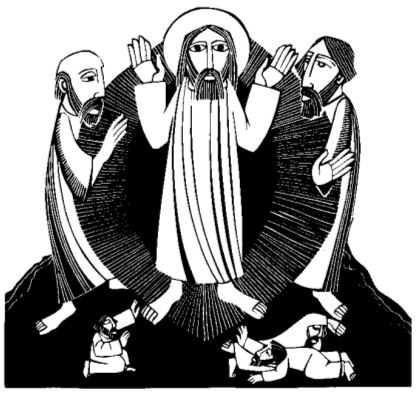Today we are encouraged to follow our feelings to determine what is right and wrong. We are called to be authentic in deciding what is good and evil, even if—especially if—it conflicts with traditional religious norms. But does the Transfiguration tell us a different story?
But can we just invent our own language of what is good and evil?
Lost Languages
I’m ashamed to admit it, but I’ve learned and then half-forgotten six different languages beyond English. I spent two years learning Spanish in high school and college. Then three years learning Hebrew and Greek while preparing for ministry. I then acquired a reading knowledge of German, French, and Latin while working on my doctorate.
Learning a language is a three-step process. First you learn the building blocks of the language—the alphabet and vocabulary. Second you add the grammar which teaches you how to string the words together. Last, along with mastering the previous two steps, you gain fluency by intimately learning the idioms and customs—something gained through contact with a native speaker.
The languages I learned faded because I only advanced through the first two steps. Fluency, or the creative and spontaneous use of a language, is something I never achieved.
Similarly, humanity has lost fluency in the language of good and evil—what we often call morality or ethics. Because of sin we lack fluency in the language of good and evil and are adrift in self-deceiving and self-destructive ways of living.
Into this vacuum we are encouraged to make up our own standards of good and evil, right and wrong. We are encouraged to be authentic to our throughs and feelings even while being conformed to the trends of our culture.
And it is here, as we reflect of the Transfiguration of Jesus, that we must tend to the words of God over Jesus: “Listen to him!”
(See this for why we should still listen to the Bible)
Confusing Good and Evil

In Genesis 3, the serpent promised Adam and Eve that if they ate from the tree of the knowledge of good and evil they would be like God in knowing good and evil. Certainly Adam and Eve came to experience good and evil after they ate from the tree, but they didn’t come to know the different between good and evil. In fact, all of humanity since have been confused about what is good and what is evil.
As Isaiah says, we have become a people who “call evil good and good evil, who put darkness for light and light for darkness” (Is. 5:20). We confuse the language of good and evil because sin has made our hearts devious and our minds darkened (Jer. 17:9; Eph. 4:18). Sin has clouded our thoughts and desires about what is good and what is evil. We have lost the basic capacities for speaking about them because of sin.
But God was unwilling to leave humanity in this state of confusion and separation—confused about what is good and separated from the One who is good. So God initiates a plan to teach us the language of what is truly good.
But we can’t just jump to Jesus and the command to “Listen to him!” We must first understand what God was doing in the Old Testament.
Law and the Prophets
The New Testament often groups the Old Testament into two sections, “law and the prophets” (check this out for brief into to how we got the Bible). It is through these that God begins to teach humanity—through Israel—what is good and what is evil.
Going back to the three steps of language learning, we could say that the law teaches Israel the vocabulary of what is good, and the prophets teach the grammar. But who is the native speaker who will teach us fluency?
The Law generally, and the Ten Commandment specifically, offer us the basic linguistic building blocks of the good. The Law gives Israel a new vocabulary for right and wrong based in the character of God’s holiness, mercy, and love. The regulation of things and people who are clean and unclean, sacred and profane, created zones of meaning and practice that teach Israel who God is, what sin looks like, and the difference between good and evil.
But knowing the vocabulary is not enough. Israel also needed to learn the grammar—they needed to learn the right way to put everything together. This is where the prophets came in.
Whether in school or at the office, people usually don’t like the grammar police. And people generally didn’t like the prophets. The prophets would tell the kings, the priests, and the people of Israel that they weren’t putting the pieces together in the right way. Samuel says that God has rejected Saul because he offered an illegitimate sacrifice. Nathan confronts David about his sin with Bathsheba. Elijah confronts Ahab and Jezebel for leading Israel into idolatry. Isaiah, Jeremiah, Ezekiel and many others remind Israel that they can’t just go through the religious motions because God desires justice and mercy more than sacrifice.
Through the law and the prophets God was giving Israel the vocabulary and grammar of the good. In fits and starts God was teaching the difference between good and evil.
But something was missing. God had given Israel the necessary building blocks through the law. God had taught the grammar through the prophets. But Israel kept turning away from God, leaving behind what is good and chasing after what is evil. Why?
In its sinful state, Israel—and all of humanity before and after—needed to learn from a native speaker, one who was fluent in what is right, good, true, and beautiful. We needed someone, untainted by sin, to come and show us what it means to live—to really live—the good life with God.
“Listen to Him!”
I failed to grasp and retain six different languages because I never practiced with a native speak. I never learned it from someone who loved the language so much that it became a joy to speak it with them.
Likewise, Israel failed to follow God because they lacked guidance from a native speaker, a fellow human being who also perfectly followed God’s law.
Jesus—the truest word of God, the Word of God through whom came the words of the law and the prophets—comes to us as a native speaker of what is good. He comes to teach and model the difference between good and evil so that we might come to know the One who is truly good. Jesus comes as the third and essential step in learning a language—fluency in relationship with a native speaker.
Only when we listen to him will we truly know what is good—the good, pleasing and perfect will of God (Romans 12:2).
The Temptations of Jesus
It is helpful to think of the temptations of Jesus as Satan’s attempt to confuse what is evil with what is good.
In the first temptation (as the Gospel of Matthew tells it) Satan tells Jesus to turn the stones into bread. It is, after all, a good thing to be provide for, to have food to live. Jesus is being tempted to provide a good thing for himself. But Jesus counters by claiming that what is truly good is the life that come through obedience to God. Jesus focuses on what is truly good, not just a passing good.
In the second temptation Satan tells Jesus to test God’s protection by throwing himself off the temple. It is, after all, a good thing to be protected by God, so why not test that protection and make sure everything is in working order. But Jesus counters by claiming that trusting God is better than testing God.
In the last temptation Satan tells Jesus that he can have all the kingdoms of earth if he would only worship him. Here Jesus is being tempted with a good thing—receiving a kingdom—gained the wrong way. After all, Jesus is the rightful king of all things so it is right and good for him to receive a his kingdom. But to receive a kingdom by worshipping Satan is evil because, as Jesus remind him, we should only worship and serve God.
In each temptation Satan is trying to confuse Jesus about what is good. But Jesus corrects these perversions by focusing on what is truly good.
Correcting distortion of what is good and what is evil runs through the ministry of Jesus. He confronts the perverted language offered by the Pharisees, scribes, and priests, and replaces it with a different understanding of what is good, holy, merciful, and loving. And the people—and the demons—notice the difference. “What is this? A new teaching,” they exclaim, “and with authority! He even gives orders to impure spirits and they obey him” (Mark 1:27).
The Transfiguration of Jesus

Moses and Elijah appeared during Jesus’ transfiguration. They represent the law and the prophets. They represent the first two steps of language learning. Moses represents the law which teaches the basic vocabulary of what is good and evil. Elijah represents the prophets who reminded Israel of the grammar of the good, pointing our errors and calling Israel to faithfulness.
But Jesus teaches us—as a native speaker—how to live what is good and resist what is evil. Through his life, death, and resurrection Jesus leads us into the depths of God’s goodness. This is why we are told to listen to Jesus. Of all people, he knows what he is talking about.
Today we are told to listen to ourselves, to listen to our feelings, to be authentic to who we are. But God is calling us to listen to Jesus.
Will we listen to him?
(First posted on Jesus Creed)


One reply on “A Forgotten Reason to Listen to Jesus”
[…] a cosmic-redemptive way, God is offering his mind to us, to restructure our brains to overcome sin and to become healthy and whole again. And this happens over time, through the story of our […]